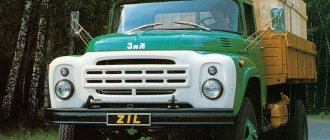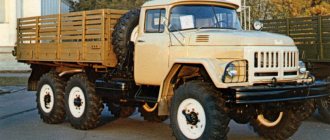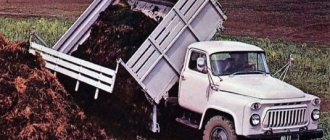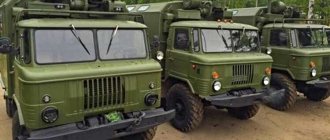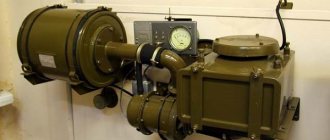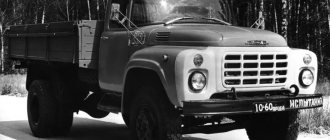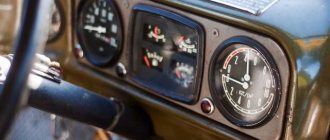Description
The weight of the ZIL 131 allows the vehicle to be classified as a truck with all-wheel drive and a front-mounted engine with a 6x6 wheel formula. The truck was originally designed as an off-road vehicle. Its task is to transport goods and people, tow trailers on any kind of soil. In the model line, this car replaced the obsolete predecessor ZIL 157.
In terms of cross-country ability, the vehicle is not inferior to many tracked competitors. The updated truck has been significantly modernized compared to its predecessor. It received an improved axle, tires with 8 layers and a special tread pattern, front-wheel drive became switchable, and a single driveshaft was installed on the transfer mechanism. The car performed excellently in difficult road and climatic conditions, operating stably and reliably in temperatures ranging from – 45 to + 55 °C.
ZIL-131 - video of off-road driving
Thanks to this prevalence not only in socialist states, but also in many, so to speak, “banana republics”, “ZIL-131”, unexpectedly for itself, made a long and successful film career in Hollywood.
In addition to dozens of films about James Bond and other numerous, lesser-known Cold War movie fighters, ZIL-131 has appeared more than once in modern foreign cinema.
In the same "Transformers", for example. Or in “The Expendables 2”: Sylvester Stallone and his “dream-team” of retro action stars famously burst into a military ZILka straight into the terrorists’ lair! At the same time, the creators of all these films, both old and new, during their filming never visited not only Russia, but even the CIS.
His element is off-road
"ZIL-131" is an all-wheel drive truck with a front-engine layout and a 6x6 wheel arrangement. Initially it was created as an all-terrain vehicle. For transporting goods and people, as well as for towing trailers - both on roads of all types and over rough terrain.
In the model range of the Likhachev Plant, the ZIL-131 replaced the no less famous, and even legendary, off-road vehicle ZIL-157.
In terms of cross-country ability, the ZIL-131 is not inferior even to tracked vehicles. This truck was created on the platform of its predecessor, the ZIL-157, which was significantly improved; equipped with an innovative bridge, eight-ply tires with a special tread pattern, and a center differential.
“ZIL-131” has proven itself to be an extremely durable machine for operation in any climatic conditions, including the Far North, tropical and equatorial latitudes, demonstrating stable and trouble-free operation at air temperatures from –45 to +55 °C.
About the history of the most popular ZIL SUV
While developing the ZIL-131, the designers of the Likhachev Plant successfully coped with the task of creating an off-road army truck that was inexpensive to produce, easy to operate and maximally unified with its “civilian counterpart.”
The first to be launched into mass production was a new mass-produced truck for the national economy - the ZIL-130; and three years after that - the army ZIL-131. However, less than five years later, from January 1971, it ceased to be a purely military vehicle and began to be mass produced as a simplified national economic truck - without the components characteristic of army vehicles.
The serial, “classic” ZIL-131 was produced for twenty years: from 1966 to 1986, when its modernized version, the ZIL-131N, was launched into production. This version was equipped with an improved engine (improved efficiency indicators, extended service life), more modern optics and an awning made of new synthetic materials.
A few years later, they began to try to equip the ZIL-131N not with carburetor, but with diesel engines: their own “ZIL-0550”; motors of others; YaMZ-236 and even Caterpillar.
However, the modernized 131st did not receive wide distribution, despite the fact that, in addition to the Likhachev plant, it was also produced at the Ural Automotive Plant until 2006. It’s just that production volumes were no longer the same. In the Urals, by the way, the ZIL-131N has been produced in recent years under the name Amur-521320.
The maximum level of production of 131 series trucks occurred in the 80s, when up to 48 thousand of these vehicles were produced per year. And the number of workers employed at ZIL by that time reached 120 thousand people. In total, the Likhachev Plant built 998,429 vehicles of the ZIL-131 family. The absolute majority of them, of course, were during the years of the USSR. And for the entire period 1987 – 2006, both enterprises assembled 52,349 cars of the updated modification - “ZIL-131N”.
The distribution of the load transmitted to the road from the mass of the equipped vehicle through the tires is: 27.5/30.45 kN (2750/3045 kgf) – front axle; 33.85/33.30 kN (3385/3330 kgf) – rear bogie.
The distribution of the load transmitted to the road from the total weight of the vehicle through the tires is equal to: 30.60/33.55 kN (3060/3355 kgf) – front axle; 71.25/70.70 kN (7125/7070 kgf) – rear bogie.
The overhang angle parameters are as follows: front without a winch - 45 degrees, with a winch - 36 degrees; rear - 40 degrees.
Engines
— The main, “native” engine of the serial “ZIL-131” is a 4-stroke eight-cylinder V-shaped 90° carburetor engine with a volume of 6 liters. Its rated power (with rev limiter) is 150 horsepower. The power unit belongs to the overhead valve type of engine, liquid cooled. The cylinder diameter is 100 mm; piston stroke – 95 mm. Compression ratio – 6.5. Torque – 41 kgf*m (410 Nm). Specific fuel consumption is at least 35-38 liters per 100 kilometers. Its considerable power needs are provided by two fuel tanks of 170 liters each.
— The 150-horsepower ZIL-5081 V8 engine, modernized in 1986, differs from the previous engine in cylinder heads with screw inlet ports and a compression ratio increased to 7.1. This engine was also slightly more economical than its predecessor.
— Diesels with which, already in its recent history, the ZIL-131 was equipped: “D-245.20” - an in-line four-cylinder diesel engine with a working volume of 4.75 liters. The rated power of this engine is 81 horsepower, the maximum torque reaches 29.6 kgm. Diesel fuel consumption is 18 liters per 100 km; YaMZ-236 is a six-cylinder V-shaped diesel engine with a volume of 11.15 liters. The rated power of this engine is 180 hp; own four-stroke diesel engine of the Likhachev plant “ZIL-0550” (6.28 l, 132 hp). However, the ZIL-131 diesel truck is still a rarity.
Frame and suspension of the ZIL-131 truck
The frame of the ZIL "SUV" is stamped, riveted, with channel-section spars, which are connected by stamped cross members. At the rear there is a hook with a rubber shock absorber; In front of the frame there are two rigid towing hooks.
Front suspension - on longitudinal springs; the front ends of the springs are fixed to the frame using lugs and pins, and the rear ends of the springs are “slippery”. The rear suspension is balanced, on two longitudinal springs. The shock absorbers (on the front suspension) are hydraulic, telescopic, double-acting.
The truck is equipped with disc wheels with 8-stud fastening. The front dependent suspension of the truck is installed on two semi-elliptic springs, equipped with shock absorbers and rear sliding ends. The rear suspension (balancer) is mounted on two semi-elliptic springs with sliding ends and 6 reaction bars.
Steering and brake control; transmission "ZIL-131"
The truck is equipped with a hydraulic power steering drive located in a common housing with the steering mechanism. The steering mechanism - the working pair - is a screw with a nut on circulating balls, and a rack that engages with a gear sector.
The power steering pump is a vane type, double acting, driven by a belt from the crankshaft pulley. The steering gear ratio is 20. The longitudinal and transverse steering rods are with heads on ball pins, with self-clamping nuts.
The brake mechanisms of the service brake system are drum type with two internal pads, unclenched by a fist, installed on all wheels. The brake drum diameter is 420 mm; pad width – 100 mm.
The total area of the brake linings is 4800 cm2. When the service brake system is turned on, the drive of the brake mechanisms is pneumatic, without separation along the axes. There are six brake chambers, type 16.
The brake mechanism of the parking brake system is a drum type with two internal shoes, unclenched by a fist, installed on the transmission shaft. The braking distance on a dry, asphalt, flat highway from a speed of 60 km/h is about 25 meters.
"ZIL-131" is equipped with a mechanical five-speed gearbox, with two inertial synchronizers for engaging second - third, fourth - fifth gears. Transfer case – mechanical, 2-speed (2.08:1 and 1:1); The main gear is double, with a pair of bevel (gear ratio 1.583) and a pair of cylindrical (gear ratio 4.25) gears. Cardan transmission is open type.
The clutch is single-plate, dry, with a spring-loaded torsional vibration damper (damper) on the driven disc. Friction linings are made of asbestos composition. The number of pairs of friction surfaces is 2.
Some modifications of the vehicle are equipped with a drum-type winch, complemented by a worm gearbox with a maximum traction force of 5000 kgf. The length of the winch cable is 65 meters.
Axles of the ZIL-131 truck
The beams of the driving axles are steel, welded from two stamped halves with welded flanges and a cover. The four cardan shafts are equipped with joints on needle bearings. The main gear is a two-stage drive of the rear axles (sequential, continuous).
The front axle drive is switched on automatically (by an electro-pneumatic valve) when the first (lower) gear is engaged in the transfer case; forced - when the second (direct) gear is engaged with a switch installed on the front panel of the cab.
When the front axle is turned on, a warning lamp on the instrument panel in the cockpit lights up. When starting, the downshift lever, which is part of the transfer case, forcibly turned on the pneumatic drive of the front axle.
"ZIL-131" is equipped with a contactless ignition system equipped with an electronic switch and an automobile generator of increased power. Additionally, there is an emergency generator, which allows, in the event of failure of the electronic switch, to move under its own power for about 30 hours, without a significant loss in dynamics.
History of creation and development
When developing the ZIL 131 car, weight and cross-country ability came to the fore. Nevertheless, the designers of the Likhachev plant successfully completed the task. The result is an inexpensive to manufacture, easy to maintain and highly unified military truck, much like its civilian counterpart under the 130 index.
It is worth noting that the version for the national economy was the first to go into production. And only three years later the army version was released. It was equipped with the appropriate components required for military specifications. However, after five years the vehicle began to be positioned as a simplified truck for civilian use. The classic 131 was mass-produced until 1986 for 20 years. Then an analogue with increased weight, the ZIL 131 N, was developed. In addition, this version received an improved engine, better efficiency parameters, a synthetic awning and modernized optics. However, this modification was not widely used, despite the fact that it was also produced at UAZ.
Device
The power unit of the car is located under the hood. The cabin is all-metal and accommodates two passengers and a driver. The driver and passengers seats are separate. The driver can adjust his seat in horizontal and vertical planes, as well as adjust the backrest tilt.
The ZIL-131 cabin was copied from the civilian 130 version - but the soldiers did not like it. After several batches were produced, it was replaced with a cabin from the ZIL-165. The car turned out to be more comfortable, the windshield became panoramic, it now consisted of two parts and provided a wide view.
ZIL-131 was similar to other domestic off-road trucks. Its main competitors were the Ural-375 and ZIL-157K. The similarity of these machines is explained by the uniform Soviet standard in force when designing such equipment. Differences could be noticed in some components and in different approaches to production.
For many years, engineers have been trying to solve a difficult problem: how to reduce the cost of a car and not lose a high level of performance characteristics? As a result, the problem was resolved, resulting in the birth of a high-quality, reliable product. After the release of the 131st, they planned to curtail the production of the 157th, however, they were produced in parallel for the next 20 years.
Exterior and cabin
Like most of their models, ZIL made the “131” model with a hooded body layout. The cabin was externally an exact copy of the 130, only mostly all samples were painted khaki.
The design also remains all-metal. Proving to be impractical, the front part was replaced, and again with a ready-made one, only now from the ZIL-165. The bent fenders and intricate grille shape were replaced with simpler but strict elements.
In the 60s of the last century, such a design was akin to revolutionary, not to mention comparing the new model with the “157” model. For almost forty years, the appearance of the military truck changed only in small details. What catches your eye most is the new windshield, which has been made panoramic.
It was not advisable to hide the engine under the cabin, since this negatively affected several factors at once: access to the engine compartment in the field worsened, and if the engine was damaged during combat operations, an increased danger was created.
Considering the focus on army needs, the appearance was similar to its other brother in the class - Ural-375. There was one country, and enterprises were completely subordinated to the state. The main differences were different solutions to technical issues and engineering structures.
The body had typical characteristics, having on board two folding benches and one removable one. The sides cannot be folded down, except for the rear one, but this does not interfere with convenient shipping and loading.
To stretch the awning, you can install special arcs. The structure of the vehicle made it possible to install other modules instead of a cargo body, such as a field kitchen, a first-aid post, a radio station, and Katyusha and S-125 missile launchers; as well as civilians - a boom with a cradle, a fire truck.
It was comfortable to be inside due to several innovations. The already mentioned windshield has significantly improved visibility compared to the previous version of the “157”. Improved thermal insulation allows you to drive the car warmly, even in winter frosts.
The driver's seat was separate from the double passenger seat and was adjustable in height, reach and backrest angle. The dashboard has a minimum number of sensors that provide the driver with all the necessary information:
- Gasoline level;
- Voltmeter/ammeter;
- Speedometer;
- Oil pressure;
- Temperature level;
- Tachometer.
Of the controls, only one is located on the steering column - the turn lever. Large mirrors provide a good view of the rear view, reducing the blind spot to a minimum, even with a trailer.
Characteristics and weight of the ZIL 131 car
Parameters of the truck in question:
- length/width/height (mm) - 7040/2500/2510;
- wheelbase (mm) - 3350/1250;
- ground clearance (under the front axle/in the area of intermediate and rear drive) (mm) - 330/355;
- wheel track front and rear (mm) - 1820;
- minimum turning radius (mm) - 1002;
- tires - 12.00/20;
- cargo platform dimensions (mm) - 3600/2320/569;
- loading height (mm) - 1430;
- weight of empty ZIL 131 (curb) (kg) - 5275 (6135);
- load capacity indicator (on highway/dirt road) (t) - 5.0/3.5;
- total weight of the truck with winch (kg) - 10425.
The load on the road from the mass of the vehicle is distributed as follows: front axle - 2750/3045 kgf, rear bogie - 3385/3330 kgf.
ZIL-131 Fuel consumption Dimensions Load capacity Weight Tank volume
The three-axle ZIL-131 is the main model of the off-road truck of the Moscow Likhachev Plant from 1966 to 1994. This is one of the most famous and recognizable cars of the Soviet automobile industry throughout the world. “ZIL-131” is, first of all, a military vehicle, which for decades was supplied to the Soviet army and the armed forces of countries allied with the USSR.
Power units
The serial onboard ZIL 131, the weight of which is indicated above, was equipped as standard with a four-stroke carburetor engine with 8 cylinders and a volume of 6 liters. The nominal power is 150 “horses”, the average fuel consumption is 36-39 l/100 km. The engine belongs to the overhead valve category and has liquid cooling.
In 1986, they began installing an improved power unit with a capacity of 150 horsepower on some modifications. It differed from its predecessor in the cylinder block, the heads of which received screw-type intake valves and increased compression (7.1). In addition, the engine has become more economical than its standard counterpart.
Diesels were rarely installed on this truck. For these purposes, the following types of motors were used:
- D-245.20. Engine with in-line placement of four cylinders, volume 4.75 liters. Power - 81 hp. s, fuel consumption - 18 l/100 km.
- ZIL 0550. Own-produced power unit with four strokes, volume 6.28 liters, power rating 132 hp. With.
- YaMZ-236. V-shaped engine with six cylinders, volume 11.1 liters, power 180 “horses”.
Video
The Likhachev plant produced many modifications of the model. Among them:
- ZIL-131 – basic modification, production of which lasted from 1967 to 1986;
- ZIL-131A is a version with unshielded electrical equipment migrated from the ZIL-130. Its differences from the basic version were the absence of special military equipment, a middle bench in the body and a searchlight. Production of the car ended in 1971;
- ZIL-131V is a truck tractor built on the basis of the ZIL-131. The car had 2 spare wheels, a shortened frame and a fifth wheel coupling. The car was used to transport goods together with a semi-trailer weighing 12,000 kg (on dirt roads - 10,000 kg). Produced from 1968 to 1986;
- ZIL-131D – experimental chassis for dump trucks;
- ZIL-131D is a model with the same name and a Caterpillar engine, created in 1992. Its production lasted 2 years;
- ZIL-131N is a modernized version of the basic model. The main differences: a new ZIL-5081 engine, an increased service life (250 thousand km), an awning made of synthetic material and improved optics. Production of the ZIL-131N ended in 1987;
- ZIL-131NA – analogue of ZIL-131N with unshielded electrical equipment;
- ZIL-131NV – truck tractor with an improved platform;
- ZIL-131N1 – modification with a 105-horsepower diesel unit “D-245.20”;
- ZIL-131N2 – version with a 132-horsepower diesel unit “ZIL-0550”;
- ZIL -131S and ZIL -131AS are northern versions. These models were equipped with a cabin with an autonomous heater, frost-resistant rubber products, additional thermal insulation, fog lights, battery insulation and double glass. Cars were used in temperatures down to -60 degrees;
- ZIL-131NS, ZIL-131NAS and ZIL-131NVS - improved versions in the northern version;
- ZIL-131X - model for desert and hot areas;
- ZIL-131-137B – road train.
Frame part and suspension unit
The decent weight of the ZIL 131 vehicle required the use of a reliable and durable frame. It is made by stamping and riveting. The unit is equipped with channel-type spars connected to each other by stamped transverse ribs. There is a hook with a rubber shock-absorbing element in the rear, and a pair of rigid towing hooks in the front.
The front suspension is equipped with longitudinal springs, the front edges of which are fixed to the frame by means of fingers and “ears”. In this case, the rear ends of the knot are of the “sliding” type. The rear analogue is of a balanced configuration with a pair of longitudinal springs. The front shock absorbers are double-acting hydraulic telescopes.
Service
Maintenance of the motor is quite simple, so even a non-specialist can handle this process. Approximately every 15 thousand kilometers it is necessary to inspect and service the engine. When performing maintenance on the machine, you need to replace the engine oil, as well as the centrifugal oil filter.
Each maintenance is a set of special operations and procedures that are necessary in order to maintain the proper technical condition of the machine. To service the ZIL 131 engine, you will need to perform the following operations and procedures:
- Change of oil;
- valve mechanism adjustment;
- replacement of the filtration system. It is worth noting that, depending on the modification of the engine, some filter elements may be missing, in particular this applies to the fine and coarse oil filter, fuel cleaning system and air filter;
- other power unit maintenance procedures.
Malfunctions, breakdowns and repairs
If any problems or breakdowns are discovered during maintenance, repairs will be required.
Almost nothing lasts forever, the same applies to the ZIL 131 engine. The engine can fail, so in-line repairs are very common. However, often in-line repairs may not be effective for certain faults, so it is necessary to resort to special methods for correcting them.
The most common breakdowns you can encounter are:
- If the engine refuses to start, or starts very poorly, although the starter is working normally, then the problem is that there is no fuel in the carburetor float chamber. To fix the problem, you need to purge the fuel lines, recheck the function of the carburetor needle valve and the fuel pump system.
- Sometimes the ZIL 131 engine may operate with certain interruptions or quickly stop at idle. In this case, most likely the cause of the malfunction is that the carburetor float chamber is slowly filling with fuel liquid. To eliminate the malfunction, you need to wash the needle valve, bleed the lines and wash the fuel coarse filter.
- If the ZIL 131 engine suddenly stops and refuses to work, you will have to contact a service center for a thorough diagnosis and establish the reason for the stoppage, because the problem is internal.
- If the engine cannot fully develop its power, then it is necessary to adjust the clearances in the valve system.
- If knocking and crackling noises are heard in the engine, then most likely there is a large gap between the valves and rocker arms. In this case, you need to properly adjust the distance in the valve system.
- If during operation of the machine there is too much excessive consumption of fuel fluid, then the problem may be an increased level of fuel in the carburetor chamber. It is necessary to remove the leakage of the needle valve or set the needle position correctly.
Of course, the problems presented and the ways to solve them are superficial and the most common. Other malfunctions may also occur with the same symptoms, which require a completely different approach to repairing the ZIL 131 engine. It is for this reason that if you do not know for sure what the malfunction is, you should not try to carry out repairs yourself. This is especially true when we are talking about an amateur motorist and not a specialist.
Steering and brakes
The truck in question is equipped with a power steering system, placed in a common compartment with a control mechanism. The last element is a working pair with a screw and a nut on hinges, as well as a rack with gearing. The hydraulic booster pump is a plate type and is driven into rotation by the crankshaft pulley belt. Longitudinal-transverse rods - with heads on ball elements, are equipped with self-clamping crackers.
The truck's brakes are drum brakes with a pair of internal pads. The parts are released using a cam mechanism located on all wheels. The diameter of the drum is 42 centimeters, the width of the pads is 10 cm. When the brake system is activated, the pneumatics are activated, without axial separation. The parking block is mounted on the transmission shaft, also of the drum type. The braking distance at a speed of 60 km/h is approximately 25 meters.
Conclusion
Transport was in great demand, so it was used in all regions of the USSR. The truck was exported to Africa and Asia. Over 23 years of production, about one million cars of various modifications were produced. In 1990, production was moved to the Urals, where it continued for another 12 years, after which they began to produce an analogue of the truck under a different name.
The car continues to be used today. Its dimensions allow you to move around the city to various construction and utility sites. The ZIL-131 has never used diesel, but some owners install diesel engines themselves to reduce fuel costs.
On the secondary market, such a truck from 90-91 can be bought for 100-110 thousand rubles. “Young” copies of the early 2000s will cost the buyer 350-400 thousand. The final price tag depends on the external and technical condition of the vehicle. Some owners rent out ZiLs. The average price is 1000 rubles per hour.
Transmission unit
Knowing the weight of the ZIL-131, you need to understand the type of system that controls the movement of such a large vehicle. The truck in question is equipped with a manual transmission with five modes. The block circuit includes a pair of inertial synchronizers. The transfer case is also mechanical, with a cardan transmission in an open configuration.
A dry single-plate clutch is combined with a spring type damper of rotational vibrations. The element is located on the driven disk. The number of rubbing pairs is two, the friction linings are made of asbestos composition. Some car models are equipped with a winch, an additional worm gear, and the cable length is 65 meters.
Specifications
The ZIL-131 engine is very similar to its older “relative” 157. The technical features of the 131st engine have become significantly better, the power is much greater, and the design problems of the previous system have been taken into account and corrected.
So, among the basic and most significant technical parameters, it is worth highlighting the following:
- The total engine capacity is 6 liters or 5969 cubic centimeters.
- Configuration - V8.
- Engine arrangement of in-line and longitudinal type.
- Fuel consumption is approximately 59.5 liters per 100 kilometers.
- The ZIL-131 engine has 8 cylinders that operate in this order: 1-5-4-2-6-3-7-8.
- The system is equipped with 16 valves.
- The diameter of the piston system is 100 millimeters.
- The ZIL-131 engine is cooled by liquid.
- The power structure of the machine is carburetor.
- The total weight of the ZIL-131 engine is 490 kilograms.
Absolutely all ZIL 131 engines are equipped with a 5-speed manual gearbox. The transfer case has a two-stage structure.
Cabin and body
The cabin of the truck in question is of an all-metal configuration, with three seats and additional thermal insulation. The unit is heated using a liquid method, from the motor cooling system with a centrifugal fan. The heater is controlled using a special damper on the cab panel. Ventilation is provided by roll-down windows, rotating windows and a channel in the right wing mudguard. The seats inside are separate, the driver's seat is adjustable, the cushions are made of a sponge rubber compound.
The body of the ZIL 131 car is a wooden platform with a metal edging and transverse base beams. Of all the sides, only the rear element is folding. The cargo platform is designed to transport people. The side compartments have folding benches for 16 seats. In addition, there is an additional eight-seater bench located in the middle part of the body. The protective awning is installed on removable arches.
Price
On the Internet you can see many advertisements for the sale of used ZIL 131 trucks of various types and purposes (flatbeds, dump trucks, fuel tankers and others). At the same time, the cost of a car can vary from 100 to 300 thousand rubles, since the technical condition of the car is different. If we talk about newer models of trucks with a diesel engine, then we are talking about prices from 500 thousand to a million rubles. ZIL 131 engines are practically not sold separately, because they are not used anywhere else.
Peculiarities
Based on the universal chassis of the specified truck, various modifications of special vehicles were produced. Among them:
- Fire trucks.
- Fuel trucks and fuel tankers.
- Oil refillers.
- Tank trucks.
- Airfield tractors with increased weight.
For military laboratories, workshops, radio stations, and headquarters versions, standard universal, sealed bodies were used. They were equipped with special filtration systems that take air masses from outside and supply them to the van, while simultaneously disinfecting the interior.
KUNG from ZIL 131, dimensions and weight:
- length - 4.8 m;
- height - 1.95 m;
- width - 2.2 m;
- weight (dry/curb) - 1.5/1.8 t.
Engine
ZIL-131 is equipped with a wide range of power units. However, the most widely used versions are those with a gasoline engine, the ZIL-5081 model. This 8-cylinder, 4-stroke V-shaped carburetor unit is equipped with a “P-16B” heater, which ensures normal operation in winter. The engine is liquid cooled and lightweight.
Power plant characteristics:
- working volume – 5.97 l;
- rated power - 150 hp;
- maximum torque – 402 Nm;
- rotation speed – 3200 rpm;
- cylinder diameter – 100 mm;
- compression ratio – 6.5.
For driving in dusty areas, the engine is equipped with a special foam-oil filter with a 3-stage air purification system. A reliable, high-capacity fuel pump allows for smooth operation at high temperatures.
Bottom line
As many years of practice have shown, the ZIL 131 has proven itself to be a reliable, durable and easy-to-maintain truck. Its main advantage is its high cross-country ability, which guarantees passage with a full load of washed-out and clayey areas. An additional bonus is the presence of a reduction gear, and mechanical tire inflation allows you to adjust the tire pressure, depending on the road surface and axle load.
In addition, drivers note a relatively comfortable cabin and easy access to main parts, which increases the machine’s maintainability. Despite the fact that the serial production of this vehicle was completed many years ago, it can still be found in various sectors of the economy.
Weight, dimensions, load capacity
The weight and overall characteristics of the vehicle of this type are relatively small, despite its main purpose. The parameters are as follows:
- curb weight of the model without winch – 6,135 kg;
- curb weight of the model with winch is 6,375 kg.
Although, according to the technical specifications, the weight of the winch mechanism of the ZIL-131 vehicle is quite significant, its presence is always justified, since it allows you to cope with movement in extremely difficult and extreme terrain conditions.
Gross vehicle weight:
- with a winch - 10,425 kg;
- without winch - 10,185 kg.
The maximum load capacity is only 3,500 kg. Also, if necessary, the equipment in question can be used in conjunction with a trailer.
Its permissible weight depends on the road conditions in which the ZIL-131 travels:
- weight when driving on a paved road – 6,500 kg;
- when driving on a dirt road – 4,000 kg.
The basic version of the car has the following overall dimensions:
- length from the front bumper to the rear of the body, mm – 7,040;
- height without awning, mm – 2,480;
- height with awning, mm – 2,975;
- width from left wheel to right, mm – 2,500.
The ground clearance of the ZIL-131 is as much as 330 mm, which allows you to move without much difficulty even over rough terrain - in forests, fields or other similar places.
The distance between the wheels is 3.35 m +1.25 m. The width of the front and rear tracks is the same and is 1.82 m. The turning radius is as much as 10.8 m. Considering the length of the body, this parameter is not that great.
The braking distance is 29 m at 50 km/h. The reason for this is the large inertia arising from the mass of the entire car and van with people, as well as all the equipment available.

